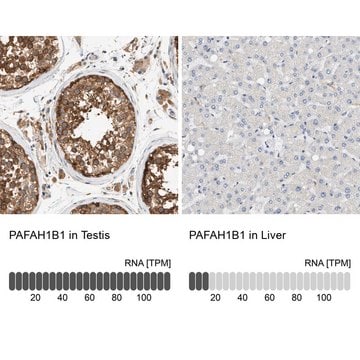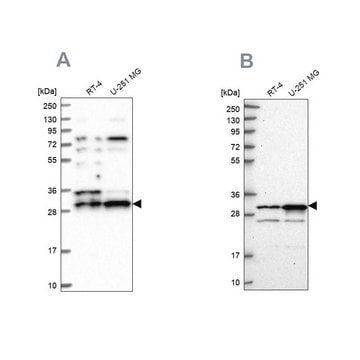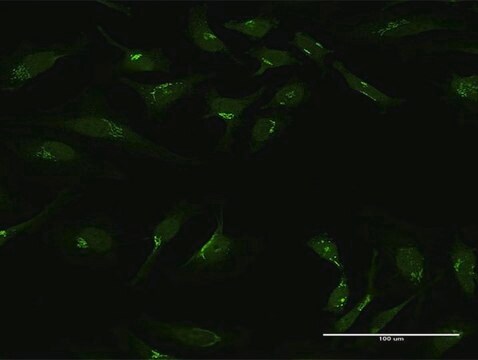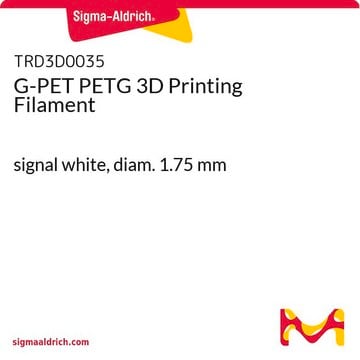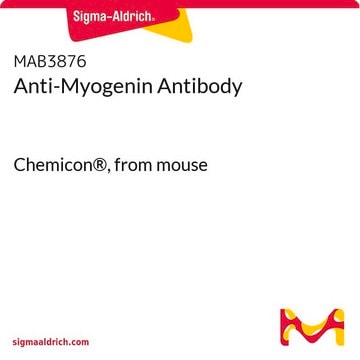ABN1720
Anti-Ninein
serum, from rabbit
Synonym(e):
Ninein, Glycogen synthase kinase 3 beta-interacting protein, GSK3B-interacting protein
About This Item
Empfohlene Produkte
Biologische Quelle
rabbit
Qualitätsniveau
Antikörperform
serum
Antikörper-Produkttyp
primary antibodies
Klon
polyclonal
Speziesreaktivität
rat, human, mouse
Methode(n)
immunocytochemistry: suitable
immunofluorescence: suitable
immunohistochemistry: suitable
western blot: suitable
NCBI-Hinterlegungsnummer
UniProt-Hinterlegungsnummer
Versandbedingung
ambient
Posttranslationale Modifikation Target
unmodified
Angaben zum Gen
mouse ... Nin(18080)
Allgemeine Beschreibung
Spezifität
Immunogen
Anwendung
Immunocytochemistry Analysis: A 1:500 dilution from a representative lot detected cytoplasmic and centrosome ninein immunoreactivity in 0.1 Triton X-100 extracted and 4% paraformaldehyde-fixed HEK293T cells (Courtesy of Professor Kensuke Hayashi, Sophia Univesity, Japan).
Immunofluorescence Analysis: A representative lot detected ninein immunoreactivity in the centrosome of proliferative apical progenitor cells (APs) by fluorescent immunohistochemisty staining of 4% paraformaldehyde-fixed cerebral cortex cryosections from E17.5 rat embryos. Ninein immunoreactivity was found downregulated in embryo sections from small eye rats with homozygous rSey2/rSey2 Pax6 mutation (Shinohara, H., et al. (2013). Biol Open. 2(7):739-749).
Immunofluorescence Analysis: A representative lot detected intense ninein immunoreactivity at the ventricular surface by fluorescent immunohistochemisty staining of 4% paraformaldehyde-fixed cerebral cortex cryosections from E13 and E18 mouse embryos. Lower immunoreactivity was also observed in the E18 cortical plate (CP), but was of much weaker intensity in the E13 cortex (Ohama, Y., and Hayashi, K. (2009). Histochem. Cell Biol. 132(5):515-524).
Immunocytochemistry Analysis: A representative lot detected granular ninein immunoreactivity in somatodendritic compartment, but not in the axon by fluorescent immunocytochemistry staining of 4% paraformaldehyde-fixed cultured cortical neurons from E18 mouse embryos. About 60% of ninein granules are associated with microtubules and showed resistance to 0.5% Triton X-100 (Ohama, Y., and Hayashi, K. (2009). Histochem. Cell Biol. 132(5):515-524).
Immunohistochemistry Analysis: A representative lot detected ninein immunoreactivity in the cortical plate (CP), white matter (WM), and the ventricular zone (VZ) of paraffin-embedded embryonic E16.5 mouse brain sections. Ninein immunoreactivity was found downregulated in the CP and WM, but not VZ, of Sip1fl/flNexCre embryos with hippocampal granule cell-targeted Sip1 knockout (Srivatsa, S., et al. (2015). Neuron 85(5):998-1012).
Western Blotting Analysis: A representative lot detected ninein in cortical lysate from postnatal P0, P3, P4 and P7 mouse brain tissue homogenates (Srivatsa, S., et al. (2015). Neuron 85(5):998-1012).
Note: Extracting soluble ninein under microtubule-stabilizing conditions with 0.5% Triton X-100 in the presence of 10 M paclitaxel (Cat. Nos. 580555 & 580556) prior to fixation can be employed to better visualize microtubule- and centrosome-associated ninein immunoreactivity (Ohama, Y., and Hayashi, K. (2009). Histochem. Cell Biol. 132(5):515-524).
Qualität
Immunocytochemistry Analysis (ICC): A 1:500 dilution of this antiserum detected ninein in NIH/3T3 cells..
Zielbeschreibung
Sonstige Hinweise
Not finding the right product?
Try our Produkt-Auswahlhilfe.
Lagerklassenschlüssel
12 - Non Combustible Liquids
WGK
WGK 1
Flammpunkt (°F)
Not applicable
Flammpunkt (°C)
Not applicable
Analysenzertifikate (COA)
Suchen Sie nach Analysenzertifikate (COA), indem Sie die Lot-/Chargennummer des Produkts eingeben. Lot- und Chargennummern sind auf dem Produktetikett hinter den Wörtern ‘Lot’ oder ‘Batch’ (Lot oder Charge) zu finden.
Besitzen Sie dieses Produkt bereits?
In der Dokumentenbibliothek finden Sie die Dokumentation zu den Produkten, die Sie kürzlich erworben haben.
Unser Team von Wissenschaftlern verfügt über Erfahrung in allen Forschungsbereichen einschließlich Life Science, Materialwissenschaften, chemischer Synthese, Chromatographie, Analytik und vielen mehr..
Setzen Sie sich mit dem technischen Dienst in Verbindung.